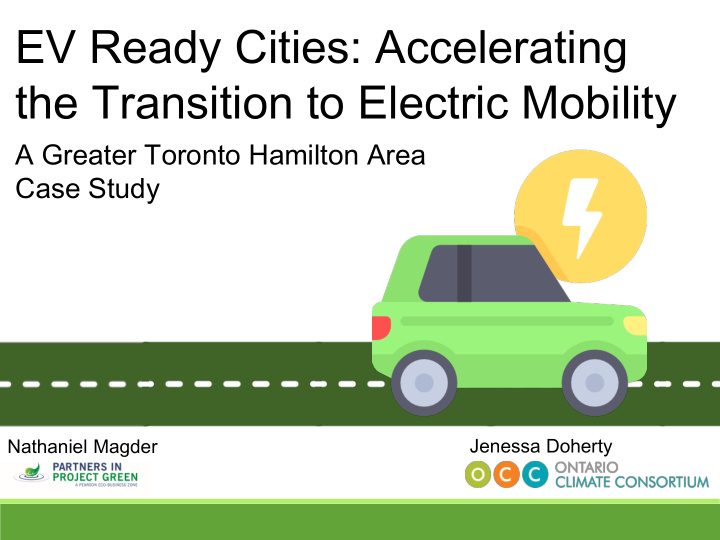



EV Ready Cities: Accelerating the Transition to Electric Mobility A Greater Toronto Hamilton Area Case Study Nathaniel Magder Jenessa Doherty
GHG Emissions by Sector and Municipality (2015) Source: The Atmospheric Fund. (2018, July). Keeping Track: 2015 Carbon Emissions in the Greater Toronto and Hamilton Area
Transportation Emissions per Capita by Municipality Source: The Atmospheric Fund (2018, July). Keeping Track: 2015 Carbon Emissions in the Greater Toronto and Hamilton Area
Cities to Learn From Source: The International Council on Clean Transportation (Nov. 2017). Electric vehicle capitals of the world: What markets are leading the transition to electric?
TOP 25: Electric Vehicle Sales and Market Sales Shares (2017) Source: The International Council on Clean Transportation (October, 2018). Electric vehicle capitals: Accelerating the global transition to electric drive
Types of Intervention 1) Incentives 2) Infrastructure 3) Partnerships 4) Education/Awareness 5) Municipal Fleet
Incentive-Based Intervention FINANCIAL NON-FINANCIAL Municipal rebates (Laval) Supporting building/parking Reduced/Free parking fees for codes (London, UK) EVs (Norway) Access to HOV lanes (California) Exemption from toll roads Residential parking permit priority (Norway) for EV users (Amsterdam) o Enforcement of EV designated spaces
Infrastructure-based Intervention o City property chargers o Streetlight chargers o Residential construction and upgrades o Portable chargers o Working groups o Ex: : Ams mster terda dam, m, Vanco couver ver
Partnership-based Intervention o Car-share programs o City contract preference o Taxi and ride-share programs o Ex: : Beiji ijing, ng, Londo ndon
Education/Awareness- based Intervention o Community education and discussion o Transparency and open dialogue o Mobile apps (charging station maps, fee trackers, carbon savings) o Report Cards (assess existing policies, o Ex: Vancouver uver
Municipal Fleets City-owned vehicles (public transportation, city vehicles, parks & rec, etc.) Ex: Vancouver
Model Cities’ Interventions
Model Cities’ Interventions
Local Municipal Policy Initiatives
Read the Report www.climateconnections.ca “Our Work” https://climateconnections.ca/app/uploads/2018/07/Onli ne-Version-Final-Report-EV-Ready-Cities.pdf
Helpful Documents/Resources The International Council on Clean Transportation. 2018, October. Electric vehicle capitals: Accelerating the global transition to electric drive. https://www.theicct.org/sites/default/files/publications/EV_Capitals_2018_final_20181029.pdf The International Council on Clean Transportation. 2017, November. Electric vehicle capitals of the world: What markets are leading the transition to electric? https://www.theicct.org/sites/default/files/publications/World-EV-capitals_ICCT- Briefing_08112017_vF.pdf The Atmospheric Fund. 2018, July. Keeping Track: 2015 Carbon Emissions in the Greater Toronto and Hamilton Area. http://taf.ca/wp-content/uploads/2018/09/TAF_Emissions-Inventory- Report_2018.pdf Transportation Research Board and National Research Council. 2015. Overcoming Barriers to Deployment of Plug-in Electric Vehicles. Washington, DC: The National Academies Press. https://doi.org/10.17226/21725. Sierra Club and Plug in America. June 2018. AchiEVe: Model State & Local Policies to Accelerate Electric Vehicle Adoption. https://www.sierraclub.org/sites/www.sierraclub.org/files/blog/EV%20Policy%20Toolkit.pdf
Next Steps: Supporting Region of Peel Municipalities o Provide background research and a framework for Peel Community Climate Change Partnership o Primary and secondary research o Exploring which areas should be key focus specifically suited for Peel demographics o Exploring potential partnership opportunities
PPG Open EV Network 2015- 2017 Update and Summary of Key Lessons Learned November 21 st , 2018
EV Network: Lessons-Learned Project Overview 144 EV charging ports installed 18 organizations both private and municipalities, ~ $660,000 private capital invested Includes two of the largest single-location installations in Ontario: Orlando Heartland Town Centre (28 ports) and Toronto Pearson airport (32 ports) As of end of 2017: Over 20,000 charging sessions, 840k km of vehicle travel, 206 tonnes eCO2 avoided
EV Network: Lessons-Learned Average Costs • $4,000-$6000 total installed cost was typical per L2 port • DCFCs could range from $40,000-$100,000+ • No PPG members have installed L1 stations • Economies of scale less relevant than installation considerations
EV Network: Lessons-Learned Station Management • Rare for owner to charge fee for use • Pricing measures to prevent parking beyond required charging period are effective • TRCA head office location serves 6 employees and 4 fleet vehicles with 4 ports • Software solutions such as queuing and billing by kWh can allow for further asset optimization • Plug-sharing management restrictions include property laws and vehicle alarms
EV Network: Lessons-Learned EV Policy Example: Pratt & Whitney • In preparation for WEVCIP, P&WC developed an internal policy to address employee requests for workplace charging • 10+ EV drivers at facility without workplace stations
EV Network: Lessons-Learned EV Policy Case Example: Bentall Kennedy • Install stations upon tenant request • Seen as increasing asset value, tenant amenity and part BK’s green initiatives • Typically put in motion immediately, though cost considerations can cause delays in smaller facilities to integrate into budget cycles
EV Network: Lessons-Learned Data Analysis: High-use site • Pearson Airport is the largest single-site installation in the province (possibly the country) • 10 DCFCs and 12 L2s for public use
EV Network: Lessons-Learned Data Analysis: High-use site • Sessions: 33,860 cumulative – 129 peak daily – 24,000 in last 12 months • Unique users: 3,400 in last 12 months • Lifetime Emissions (Mar 2017-Nov 2018): 395,000 kWh delivered = 396 tCO2 avoided Source: Chargepoint
EV Network: Lessons-Learned Data Analysis: Ontario-wide • Provincial data collected from EVSE network operator (Spring 2017) • Anonymized by postal code and facility type • Shows opportunity for tracking high use areas at later stages of network development • Mapping analysis for siting could include: Charging station data, traffic and parking data, grid capacity, etc. Source: Charge Point
Jenessa Doherty Thank you! jenessa.doherty@trca.on.ca Nathaniel Magder nathaniel.magder@trca.on.ca GHG Targets
Recommend
More recommend